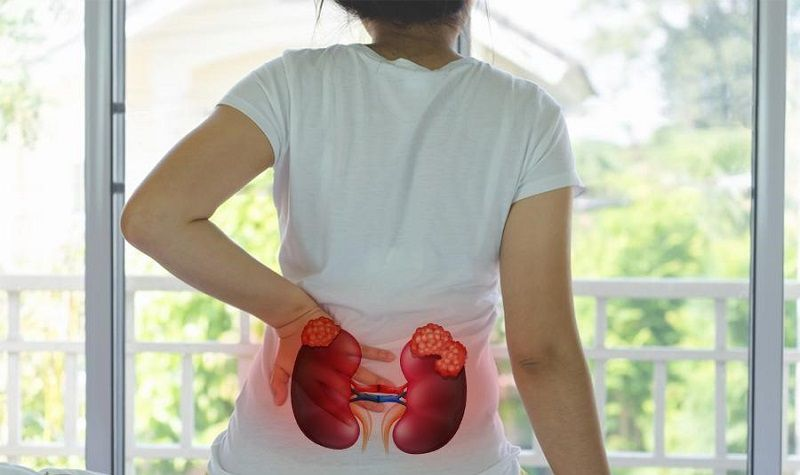A kidney abscess is the phenomenon of pus formation around or in the kidney due to infection of the soft tissues surrounding the kidney or infection of the peripheral kidney tissue. This is a common condition due to trauma and infections related to kidney stones or kidney infections in individuals with diabetes.
1. Causes of Kidney Abscess
There are many causes of kidney abscess, among which the following are common:
- Due to urinary tract infections: bladder and urethra inflammation can spread to the kidneys, causing pyelonephritis and kidney abscess.
- Urinary tract stones: cause damage to the ureter and kidney leading to infection, which spreads to the kidney causing a kidney abscess.
- Due to pyelonephritis: creates conditions for kidney infection, leading to a kidney abscess.
- Due to bacteremia: infections in other organs such as pneumonia or peritonitis, bacteria enter the bloodstream and then into the kidney tissue, causing pyelonephritis or kidney abscess.
- Due to Mycoplasma infection: kidney abscess due to Mycoplasma can be observed after kidney transplantation.
- A kidney abscess can sometimes form due to infections in other parts of the body. Skin abscesses and intravenous drug abuse can also lead to kidney abscess.
2. Signs of Kidney Abscess:
The following signs and symptoms are most commonly observed in individuals with kidney abscess, including:
- Clear signs of infection such as high fever, chills, and rapid pulse.
- Additionally, patients often experience significant pain in the lumbar region, resembling the clinical picture of acute pyelonephritis.
In the early stages, there is no pus in the urine and the urine is completely normal, as the pus cavity is not connected to the urinary tract.
In many cases, kidney abscesses present more gradually, with the patient experiencing episodes of mild infection-related fever, a gradual decline in health, and back pain similar to chronic pyelonephritis, sometimes accompanied by kidney stones.
During examination in acute cases, pain may be felt in the lumbar region, or there may be redness and swelling in the lumbar fossa (the flank area), and sometimes a tender, palpable mass may be detected upon examination.
In cases where the disease progresses more slowly, examination of the lumbar region may not reveal severe reactions, but an enlarged, tender kidney may be observed, or an abscess may be detected, with pus potentially being aspirated.
If a kidney abscess is suspected, the doctor will conduct an examination and request several tests to determine the treatment method. Specifically:
- Urine test: Helps the doctor find blood, protein, or any bacteria present in the urine.
- Blood test: This method provides information about hemoglobin, white blood cells, etc.
- X-ray: Allows the doctor to observe the area around the kidney if the abscess is large.
- Ultrasound: Helps the doctor visualize the abscess around the kidney.
- CT and MRI: These methods help differentiate between abscesses in the kidney and those outside the kidney.
3. Is a kidney abscess contagious?
A kidney abscess is a common condition that arises from injuries and infections related to kidney stones or kidney infections in people with diabetes, so the condition is not contagious.
4. How to prevent kidney abscess
To prevent kidney abscess, it is necessary to proactively implement the following disease prevention measures:
- Regularly examine and detect early conditions that may cause water retention in the kidneys, such as kidney stones, ureteral stones, urinary tract tumors, or tumors compressing the urinary tract.
- Drink plenty of water daily and do not hold in urine. The main purpose is to flush out bacteria from the urinary tract.
- When there are signs of a urinary tract infection, seek medical examination and treatment early to avoid complications such as kidney inflammation, which can lead to a kidney abscess.
- When the infection has not completely resolved, absolutely avoid alcohol, beer, and coffee as they can make urination more difficult.
- Follow the doctor’s instructions regarding treatment.
- Additionally, maintain a healthy, scientific, and reasonable lifestyle. Regularly exercise every day to maintain health and boost immunity. Have a suitable diet, avoiding foods and drinks that are not good for health.
5. How to treat a kidney abscess
Based on the size of the kidney abscess and the patient’s health condition, the doctor may apply several treatment methods as follows:
- When the disease is in the acute stage, it only presents clinical symptoms, with no signs of localized pus: primarily treat with appropriate antibiotics and improve the patient’s condition; the disease can resolve. However, continued monitoring through tests and ultrasound is necessary to prevent recurrence and the disease becoming chronic.
- When the pus cavity has formed: Pus drainage with antibiotic treatment is the main treatment method. The drainage must be wide enough to completely remove the pus and prevent the drainage opening from becoming blocked, which could lead to residual pus formation.
- Treatment of complications: When the pus cavity ruptures into nearby organs causing complications, surgery is required to treat the complications, such as draining pleural or abdominal pus or excising the fistula to the skin.
- Treatment of multiple small abscesses: Primarily medical treatment with antibiotics, sometimes in combination with dialysis and corticosteroids, and often addressing the underlying cause of the disease, such as surgery to remove stones or resolving urinary obstruction.
Additionally, patients can manage this condition with the following measures:
- Use of pain relievers: In cases of fever or discomfort, pain relievers such as aspirin containing acetaminophen (Tylenol®) can be used according to the pharmacist’s instructions or medications prescribed by a doctor.
- Heat application: Using a heating pad placed on the abdomen, back, or side to reduce feelings of pressure or pain.
- Drink plenty of water: Drinking plenty of water daily will help flush bacteria out of the urinary tract.

